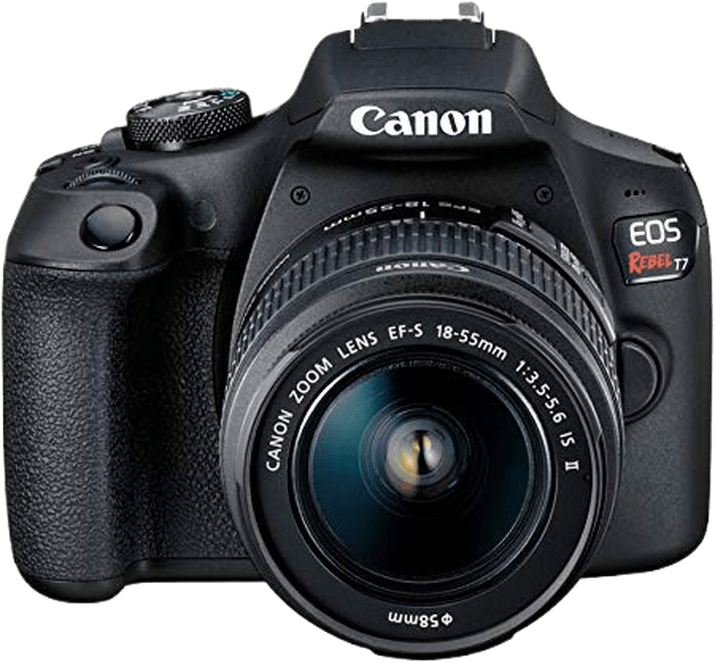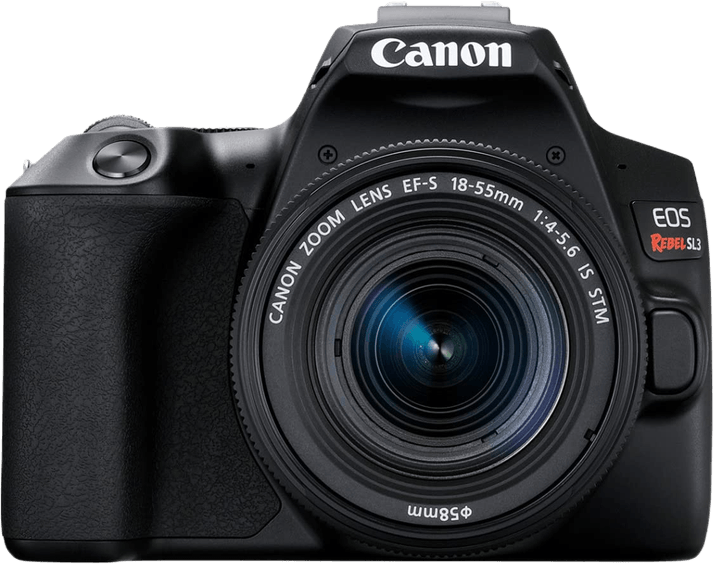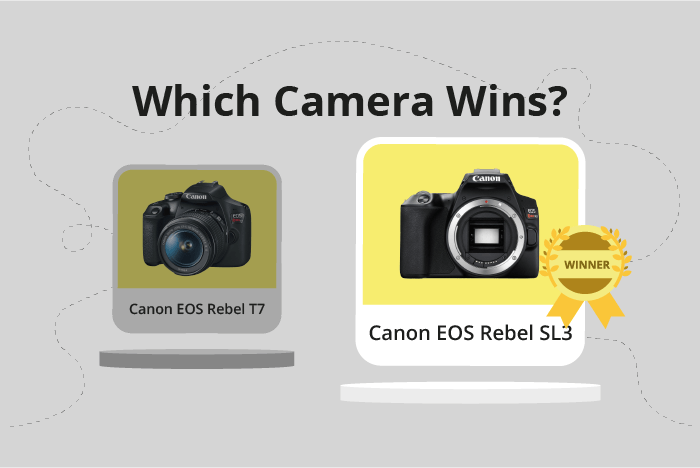Canon EOS Rebel T7 / 2000D vs Rebel EOS SL3 / 250D Comparison
Canon EOS Rebel T7 / 2000D

Canon EOS Rebel SL3 / 250D

The Canon Rebel EOS SL3 / 250D emerges as the winner with a score of 63/100, while the Canon EOS Rebel T7 / 2000D scores 50/100. Both cameras are DSLRs released in 2018 and 2019, respectively. They share similarities in their launch prices, with the SL3 costing $599 and the T7 at $550.
The SL3 outperforms the T7 in terms of size and weight, measuring 122 x 93 x 70mm and weighing 449g, making it more compact and portable. On the other hand, the T7 is slightly larger and heavier, with dimensions of 129 x 101 x 78mm and a weight of 660g.
Despite the T7’s lower score, it may be a better option for those on a tighter budget, as it is $49 cheaper than the SL3. However, considering the SL3’s advantages in size and weight, it is worth the extra investment for those seeking a more convenient and portable DSLR camera.
Canon EOS Rebel T7 / 2000D vs Rebel EOS SL3 / 250D Overview and Optics
The Canon Rebel EOS SL3 / 250D emerges as the winner in the optics comparison, scoring 61/100, while the Canon EOS Rebel T7 / 2000D trails behind with a score of 56/100. Both cameras share some common specifications, including 24.1 and 24 megapixels respectively, CMOS sensor type, APS-C sensor size, and Canon EF-S lens mount compatibility.
The SL3 / 250D outperforms the T7 / 2000D in several aspects. It boasts a faster shooting speed of 5 frames per second, compared to the T7 / 2000D’s 3 frames per second. The SL3 / 250D is also equipped with a more advanced Digic 8 processor, which contributes to better image processing and overall performance. Additionally, the SL3 / 250D features built-in image stabilization, providing sharper images and reducing the impact of camera shake.
On the other hand, the T7 / 2000D does have a slightly higher DXOMARK score for its sensor, at 71 compared to the SL3 / 250D’s 64. This means that the T7 / 2000D has better color depth, dynamic range, and low-light performance. However, this advantage is not enough to outweigh the benefits of the SL3 / 250D’s superior features.
Taking all factors into consideration, the Canon Rebel EOS SL3 / 250D is the more capable camera in terms of optics, offering a faster shooting speed, advanced processor, and built-in image stabilization. While the Canon EOS Rebel T7 / 2000D does possess a marginally better DXOMARK sensor score, it falls short in other areas, making the SL3 / 250D the preferable choice for those prioritizing optical performance.
Canon EOS Rebel T7 / 2000D vs Rebel EOS SL3 / 250D Video Performance
The Canon Rebel EOS SL3 / 250D is the clear winner in video capabilities, with a significantly higher score of 83/100 compared to the Canon EOS Rebel T7 / 2000D’s score of 43/100. Both cameras share some common video specifications, such as offering Full HD video resolution and the ability to capture video at 1920 x 1080 dimensions.
However, the SL3 / 250D surpasses the T7 / 2000D in several key aspects. Firstly, it boasts a higher maximum video resolution of 4K, allowing for much sharper and detailed footage compared to the T7 / 2000D’s Full HD resolution. Additionally, the SL3 / 250D can record video at a larger dimension of 3840 x 2160, further enhancing the quality of the captured footage. The SL3 / 250D also offers a higher maximum video frame rate of 60fps, double the T7 / 2000D’s 30fps, providing smoother motion and more flexibility in post-production. Lastly, the SL3 / 250D features built-in time-lapse functionality, which the T7 / 2000D lacks.
In contrast, the T7 / 2000D does not offer any specific advantages in video capabilities over the SL3 / 250D. The SL3 / 250D outperforms the T7 / 2000D in all the mentioned video specifications, making it a superior choice for videographers and content creators.
Taking all these factors into account, it is evident that the Canon Rebel EOS SL3 / 250D is a much better camera for video recording than the Canon EOS Rebel T7 / 2000D. This makes the SL3 / 250D a more versatile and powerful option for those looking to capture high-quality videos in addition to still photography.
Canon EOS Rebel T7 / 2000D vs Rebel EOS SL3 / 250D Features and Benefits
The Canon Rebel EOS SL3 / 250D emerges as the winner in the features comparison, with a score of 70 out of 100, while the Canon EOS Rebel T7 / 2000D scores 41 out of 100. Both cameras share some common specifications, such as a 3-inch screen size, no GPS, and WIFI connectivity.
The SL3 / 250D outperforms the T7 / 2000D in several aspects. Firstly, the SL3 has a higher screen resolution of 1,040,000 dots, compared to the T7’s 920,000 dots. This results in a sharper and clearer display on the SL3. Secondly, the SL3 has a touchscreen, making it more user-friendly and convenient to navigate menus and settings. In addition, the SL3 comes with Bluetooth connectivity, which is absent in the T7, allowing for seamless pairing with compatible devices.
On the other hand, the T7 / 2000D has a flip screen, which is also present in the SL3 / 250D. This feature allows both cameras to be more versatile in capturing images and videos from various angles. However, the T7 does not outperform the SL3 in any other aspect.
Taking into account the differences in features, the Canon Rebel EOS SL3 / 250D is a better camera than the Canon EOS Rebel T7 / 2000D. The higher score of the SL3 is due to its superior specifications, such as increased screen resolution, touchscreen capability, and Bluetooth connectivity. While the T7 does have a flip screen, it does not offer any additional advantages over the SL3. Therefore, for those seeking a camera with better features, the Canon Rebel EOS SL3 / 250D is the clear choice.
Canon EOS Rebel T7 / 2000D vs Rebel EOS SL3 / 250D Storage and Battery
The Canon Rebel EOS SL3 / 250D outperforms the Canon EOS Rebel T7 / 2000D in storage and battery, scoring 45/100 compared to the T7’s 27/100. Both cameras share some common specifications, such as having one memory card slot and accepting SD, SDHC, and SDXC memory cards. However, the SL3 is UHS-I compatible, providing faster data transfer speeds.
The winning aspect of the SL3 is its battery life, offering 1070 shots with its LP-E17 battery, nearly doubling the T7’s 500 shots using the LP-E10 battery. This makes the SL3 more suitable for longer shooting sessions without needing to change batteries. Neither camera supports USB charging, so both rely on external battery chargers.
Although the T7 falls short in this comparison, it still provides a decent battery life for casual photography. However, for extended usage and faster memory card compatibility, the Canon Rebel EOS SL3 / 250D proves to be the better option in terms of storage and battery performance.
Alternatives to the Canon EOS Rebel T7 / 2000D and Rebel EOS SL3 / 250D
Are you still undecided about which camera is right for you? Have a look at these popular comparisons that feature the Canon EOS Rebel T7 / 2000D or the Canon Rebel EOS SL3 / 250D:

